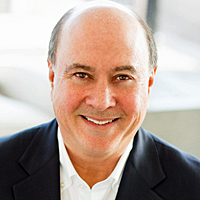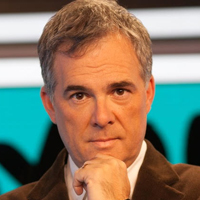Streaming’s Rise Further Squeezes Stations’ Content Pipeline, Execs Say
Streaming is squeezing TV stations’ content supply chain and bigger studios need to jump in to create more options to reduce the pressure, a panel of executives from local station groups and syndication suppliers said at TVNewsCheck’s TV2025 conference last week.

Mort Marcus
After a small resurgence of energy around first-run syndication in January with new entrants like The Drew Barrymore Show coming into the mix and Tamron Hall seeing renewal for a sophomore season, the pandemic has had a cooling effect on programming, Debmar-Mercury Co-President Mort Marcus said. He noted syndies’ ratings are down upwards of 25% with cable news networks benefitting from a COVID news-related jump in daytime ratings.
“We are getting some offset by an increase in the CPM, maybe 20%, but not enough to offset the 25%-30% decline in ratings,” Marcus said.
Angelica Rosas McDaniel, EVP of strategy and creative development at Litton Entertainment, said viewers’ habits have changed in the pandemic. While it’s not realistic to think ratings will return to their pre-COVID numbers, she thinks there will be a slow reversal of the downward trend in time.
But Scott Ehrlich, SVP of growth platforms and content at Sinclair Broadcasting Group, noted these declines predated the pandemic and the supply quality, too, had already been flagging. He said stations need to work from that understanding.
“We can’t sit back and hope that the audience and the supply chains turn around,” Ehrlich said. “Hope is not a scalable strategy.”
Further complicating the dynamic is streaming’s ascendancy in the marketplace as another destination for programming including original shows and off-nets, he added.
“If you’ve got a really good show, and you’ve got a paid subscription business that it could be used as acquisition content for, trading that off versus its value in the marketplace as a syndicated show is going to be a harder and harder call for people to make,” Ehrlich said.
With streamers’ rise, Marcus said he no longer sees a traditional off-net play in the future but rather a sharper turn to first-run programming in daytime and prime access. “There won’t be very many off-net things available,” Marcus said, noting that in nabbing one of the few current offerings, Schitt’s Creek, Debmar-Mercury had to put up an advance to get the rights.

Frank Cicha
“It’s a stretch to think that anybody running one of these streamers is going to walk to work one day and say, ‘Let’s not do this for the streamer, let’s do it for first-run syndication,’” said Frank Cicha, SVP of programming for Fox Television Stations. “That’s an impossibility right now, but that doesn’t mean we’re not going to get product.”
But Cicha also noted that streamers don’t have a lock on all potential content categories and streaming content is consumed differently than what’s featured on linear TV, with different expectations from viewers. He said his station group has placed some of its shows on Tubi, the ad-supported streaming service owned by Fox, to see how they resonate with audiences on the platform.
“The idea of developing a single show for one or the other in some ways just doesn’t make a lot of sense,” Cicha said. “It has to be targeted for one or the other as opposed to: Here’s this great show, where should we put it?”
“That’s mostly true,” Marcus said. He added streaming companies have “struggled trying to find reality shows” — like the ones a Fox group might produce, for example — that work on their platforms.
“They’re learning that it is a different experience,” Marcus said of streamers and what they provide consumers. “It is hard to find something that works in both.”
Moderator Ken Werner, former president of Warner Bros. domestic television, asked if that provides a company like Debmar-Mercury an opportunity to “step into the void.”
Marcus said he wants multiple players — especially the large studios — to join him in stepping into the void.
“I want Warner Bros. to bring a $50 million talk show in,” Marcus said. “I want Warner Bros. to try really hard to hate me and hate my shows and send a white paper about how bad my shows are. I really do.”

Scott Ehrlich
For Marcus, competition sets a high bar for content producers across the board. He added that it does nobody any good to “chase the crap down the middle,” and said “it doesn’t make any sense for the marketplace” if a company such as his becomes the most robust supplier of content to a major station group.
However, Marcus also asserted that big studios like Warner Bros. don’t appear to be upholding their end of that unwritten agreement and taking the lead in quality content production.
“Maybe in the short term we can get an advantage, assuming we can make money on a show in the environment, but long-term we’re going to need a lot of suppliers to make the stations successful because they need rating points, too, at the end of the day,” Marcus said. “We do take big swings and we want to take bigger swings; all I’m saying is it’s a healthier environment if there’s five shows vying for that ‘yes’ than one. Everybody would be healthier if it’s more vibrant.”

Angelica McDaniel
Litton’s McDaniel concurred. “There’s less people at the party and so I’m not vying [as much] for dance floor space, but we need to figure out how to engage with our partners like [Fox] and [Sinclair] and everyone else, who are having the same struggles, but on the buyer’s side — that’s the new competition,” she said.
“Instead of looking at it as: There’s eight of us coming out with a show and we’re all competing for that spot, it’s: There’s only two of us coming out for the same spot. But now how do we make the best deal? How do we create the best opportunity so we get the spot?,” she said. “So it’s still competitive, it’s just a different dance.”
Read more TV2025 coverage here.


































Comments (2)
AIMTV says:
October 28, 2020 at 10:40 am
Some really good & accurate insights here. But a few observations to add as well, first from the Supplier POV: So, “a big swing” is what? A big budget? Money is necessary but too much stifles creativity and creates so much pressure to recoup inflated cost as to actually hurt the creative process. Nothing is more freeing to a creator than knowing their future is secure and they can just do their best work. The best you tubers aren’t exactly doing multi-million dollar productions out of their basement. Storytelling, now more than ever, can outperform slick, big-budget productions.
I’d also say “the stuff down the middle” isn’t the problem, it’s the crap at the bottom. The problem with broadcast TV producers is they are broadcast TV producers. The creativity that has driven streaming, premium cable and a few primetime TV shows, to bring about a TV renaissance, has largely avoided syndicated TV. If one talk show works, do 20 more just like it. If one court show is good, then 30 must be better. The lack of creativity and storytelling is massive in broadcast TV. There are good shows out there, but to find them, a viewer must wade through a whole bunch of garbage. Most won’t do it, but those that do, when they find one they love, they hold on for dear life. Even if it means watching in the wee hours of the morning or night, they’ll do it, so rare is the good show. Too many syndicated-suppliers viewer content as that stuff between commercials and it’s more about real estate than building a solid distribution channel for truly creative product.
Secondly, from the acquisitions POV: Too many times, decisions are made based on relationships and outdated models rather than a meritocracy. A good show with good ratings, gets pre-empted, bumped, moved off the programming grid, even if it’s working. All to make way for subpar shows where the station/group has a relationship, locally produced news shows that are not very good, or shows where the station or group has an ownership stake. Owning 50% of a failure is still a failure. Put good content on the air, and people will watch. Hold the line against syndicators that jam in a crazy amount of commercials, take shortcuts on creativity with Electronic Press Kits disguised as content, and minute long (or more) credit sequences that don’t feature ANY content, killing programming flow to the next show.
Broadcast is missing this great window of opportunity to grow their audience from young cord-cutters or cord-nevers, by focusing solely on local news, live programming (sports), big budget syndicated fare and re-runs from cable. Instead of expanding the eco-system to great independent producers who don’t even consider or know about broadcast syndication, the business relies on the same-old, same-old suppliers and tired, used up genres. Heck, program directors are overseeing so many stations due to consolidation they have zero time to be creative or chase creative deals. They are working 4 jobs now and can’t do any of them well.
There are GREAT indie producers out there doing solid, creative work and their work goes directly to streamers, international (with no US Distribution), commercial free (PBS) or premium cable. Not all of it are huge budgets either. A creative producer can produce good content by simply filling unfilled but large niches, zigging while the rest of his/her peers zag, telling stories that haven’t already been told a dozen or more times, etc.
Unless it’s sports or news (glut), weekends are ignored completely rather than being a place where programmers can experiment with new genres, new suppliers, and/or blocks of programming to attract displaced cable viewers. Another great area to experiment are the digital tiers (multi-casting), instead, broadcasters sell them out to the highest bidder with a glut of cheap, retro programming that appeals to 65+. How many retro channels do we need? The highest bidder almost never creates the best content and you will never have a long term solution as long as you focus on short term answers. I know why they do it, but I just don’t agree with it.
It’s hard to continue to pound the drum of the possibilities for broadcast TV when so much of the broadcast TV industry itself, seemingly doesn’t realize the plethora of opportunities that exist.
tvn-member-5387003 says:
October 28, 2020 at 1:27 pm
Thank you for your substantive comments and insights. Would love to speak with you more about them if you’ll email me at [email protected].